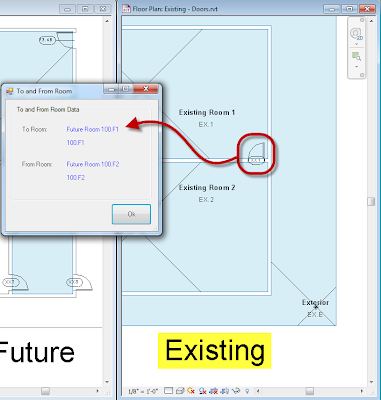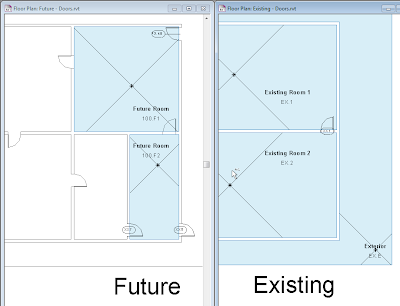The sample project consists of a command entry class, a selection manager class and one form.
The first class shown below is used to manage the selection of elements or faces in a model. This class is taken from the SDK with some minor adjustments.
Imports Autodesk.Revit.DB Imports Autodesk.Revit.UI Imports Autodesk.Revit.UI.Selection ''' <summary> ''' Selection type. ''' </summary> Public Enum SelectionType Element Face Edge Point End Enum ''' <summary> ''' A class for object selection and storage. ''' </summary> Public Class clsSelectionManager Private m_commandData As ExternalCommandData Private m_application As UIApplication Private m_document As UIDocument Private m_CreationBase As Autodesk.Revit.Creation.ItemFactoryBase Private m_elemPickedPoint As XYZ Private m_selectionType As SelectionType = SelectionType.Element Private m_selectedPoint As XYZ Private m_selectedElement As Element ''' <summary> ''' constructor of SelectionManager ''' </summary> ''' <param name="commandData"></param> Public Sub New(commandData As ExternalCommandData) ' Widen Scope m_commandData = commandData m_application = m_commandData.Application m_document = m_application.ActiveUIDocument ' Support for Family and Project Environment If m_document.Document.IsFamilyDocument Then m_CreationBase = m_document.Document.FamilyCreate Else m_CreationBase = m_document.Document.Create End If End Sub ''' <summary> ''' For specific selection type. ''' </summary> Public Property SelectionType() As SelectionType Get Return m_selectionType End Get Set(value As SelectionType) m_selectionType = value End Set End Property ''' <summary> ''' Store the selected element. ''' </summary> Public Property SelectedElement() As Element Get Return m_selectedElement End Get Set(value As Element) m_selectedElement = value End Set End Property ''' <summary> ''' Store the selected point. ''' When the point is picked, move the element to the point. ''' </summary> Public Property SelectedPoint() As XYZ Get Return m_selectedPoint End Get Set(value As XYZ) m_selectedPoint = value If m_selectedElement IsNot Nothing AndAlso m_selectedPoint IsNot Nothing Then MoveElement(m_selectedElement, m_selectedPoint) End If End Set End Property ''' <summary> ''' Select objects according to the selection type. ''' </summary> Public Sub SelectObjects() Select Case m_selectionType Case SelectionType.Element PickElement() ' pick element Exit Select Case SelectionType.Face Exit Select Case SelectionType.Edge Exit Select Case SelectionType.Point PickPoint() ' pick point Exit Select End Select End Sub ''' <summary> ''' Pick the element from UI. ''' </summary> Friend Sub PickElement() Try ' Pick an element. Dim eRef As Reference = m_document.Selection.PickObject(Autodesk.Revit.UI.Selection.ObjectType.Element, "Please pick an element.") If eRef IsNot Nothing AndAlso eRef.ElementId <> ElementId.InvalidElementId Then SelectedElement = m_document.Document.GetElement(eRef) m_elemPickedPoint = eRef.GlobalPoint End If Catch generatedExceptionName As Autodesk.Revit.Exceptions.OperationCanceledException ' Element selection cancelled. SelectedElement = Nothing End Try End Sub ''' <summary> ''' Pick the point from UI. ''' </summary> Friend Sub PickPoint() Try ' Pick a point. Dim targetPoint As XYZ = m_document.Selection.PickPoint("Please pick a point.") SelectedPoint = targetPoint Catch generatedExceptionName As Autodesk.Revit.Exceptions.OperationCanceledException ' Point selection cancelled. SelectedPoint = Nothing End Try End Sub ''' <summary> ''' Move an element to the point. ''' </summary> ''' <param name="elem">The element to be moved.</param> ''' <param name="targetPoint">The location element to be moved.</param> Friend Sub MoveElement(elem As Element, targetPoint As XYZ) Dim vecToMove As XYZ = targetPoint - m_elemPickedPoint m_elemPickedPoint = targetPoint ElementTransformUtils.MoveElement(m_document.Document, elem.Id, vecToMove) End Sub End Class
The code for the form used to display the to and from data is shown here as well after the image showing the basic layout of the controls:
Public Class Form_ToFrom ''' <summary> ''' Constructor ''' </summary> ''' <param name="p_e"></param> ''' <remarks></remarks> Public Sub New(p_e As FamilyInstance) InitializeComponent() Try ' To Room If Not p_e.ToRoom Is Nothing Then Me.LabelToName.Text = p_e.ToRoom.Name Me.LabelToNumber.Text = p_e.ToRoom.Number Else Me.LabelToName.Text = "n/a" Me.LabelToNumber.Text = "n/a" End If Catch ex As Exception Me.LabelToName.Text = "n/a" Me.LabelToNumber.Text = "n/a" End Try Try ' From Room If Not p_e.FromRoom Is Nothing Then Me.LabelFromName.Text = p_e.FromRoom.Name Me.LabelFromNumber.Text = p_e.FromRoom.Number Else Me.LabelFromName.Text = "n/a" Me.LabelFromNumber.Text = "n/a" End If Catch ex As Exception Me.LabelFromName.Text = "n/a" Me.LabelFromNumber.Text = "n/a" End Try End Sub ''' <summary> ''' Close the Form ''' </summary> ''' <param name="sender"></param> ''' <param name="e"></param> ''' <remarks></remarks> Private Sub ButtonOk_Click(sender As System.Object, e As System.EventArgs) Handles ButtonOk.Click Me.Close() End Sub End Class
Finally, here's the basic command entry and execution class used to launch the Add-In:
Imports Autodesk.Revit.ApplicationServices Imports Autodesk.Revit.Attributes Imports Autodesk.Revit.DB Imports Autodesk.Revit.UI Imports Autodesk.Revit.UI.Selection <Transaction(TransactionMode.Automatic)> Public Class Commands Implements IExternalCommand ''' <summary> ''' Entry ''' </summary> ''' <param name="commandData"></param> ''' <param name="message"></param> ''' <param name="elements"></param> ''' <returns></returns> ''' <remarks></remarks> Public Function Execute(ByVal commandData As ExternalCommandData, ByRef message As String, ByVal elements As ElementSet) As Result Implements IExternalCommand.Execute Try ' Selection Manager Dim m_mgr As New clsSelectionManager(commandData) ' Select an Element m_mgr.SelectionType = SelectionType.Element ' Pick an Element m_mgr.PickElement() ' Is it a FamilyInstance? If TypeOf m_mgr.SelectedElement Is FamilyInstance Then ' Analyze It in the Form Using m_d As New Form_ToFrom(m_mgr.SelectedElement) ' Display the Results m_d.ShowDialog() End Using End If ' Return Success Return Result.Succeeded Catch ex As Exception ' Failure Return Result.Failed End Try End Function End Class
Text





